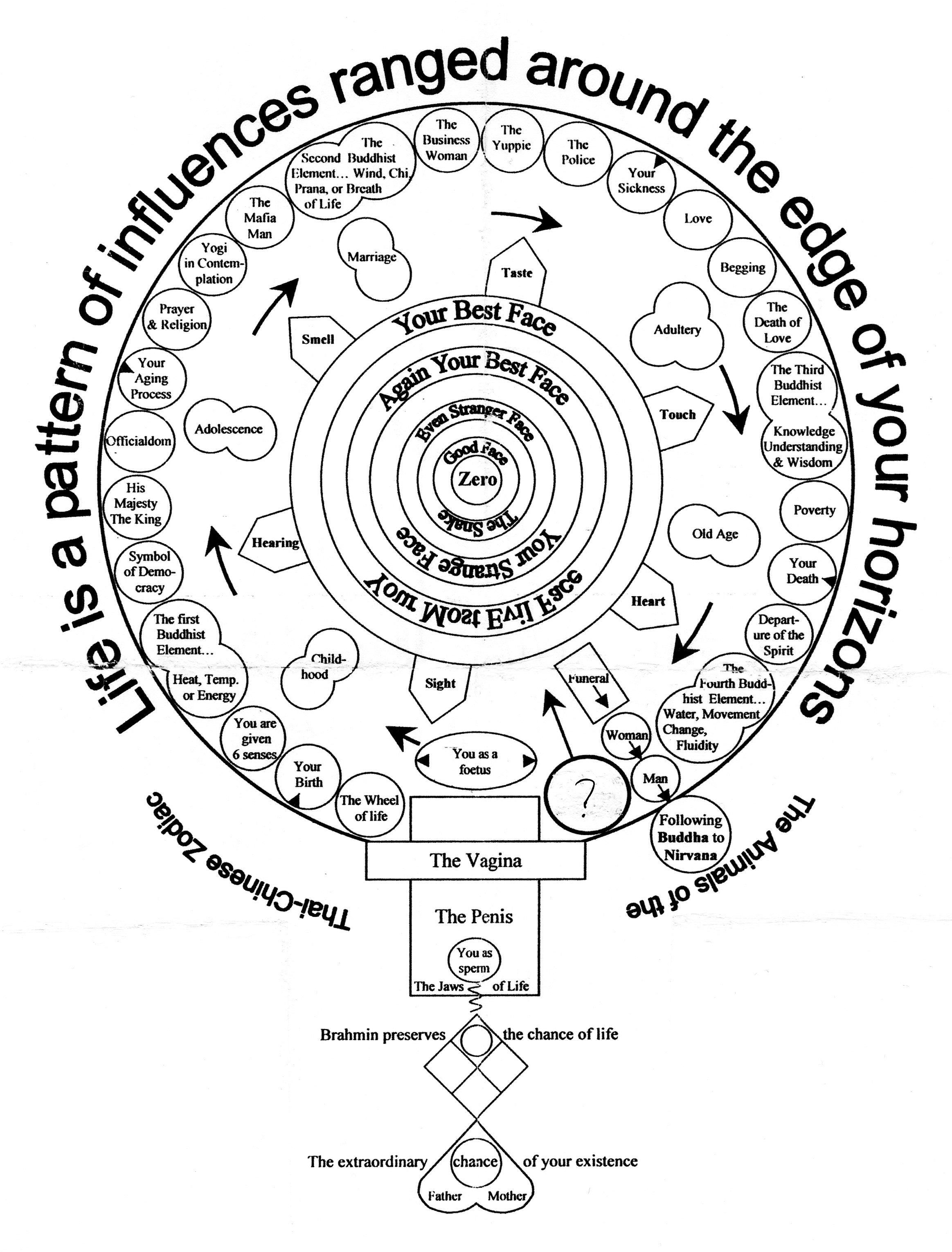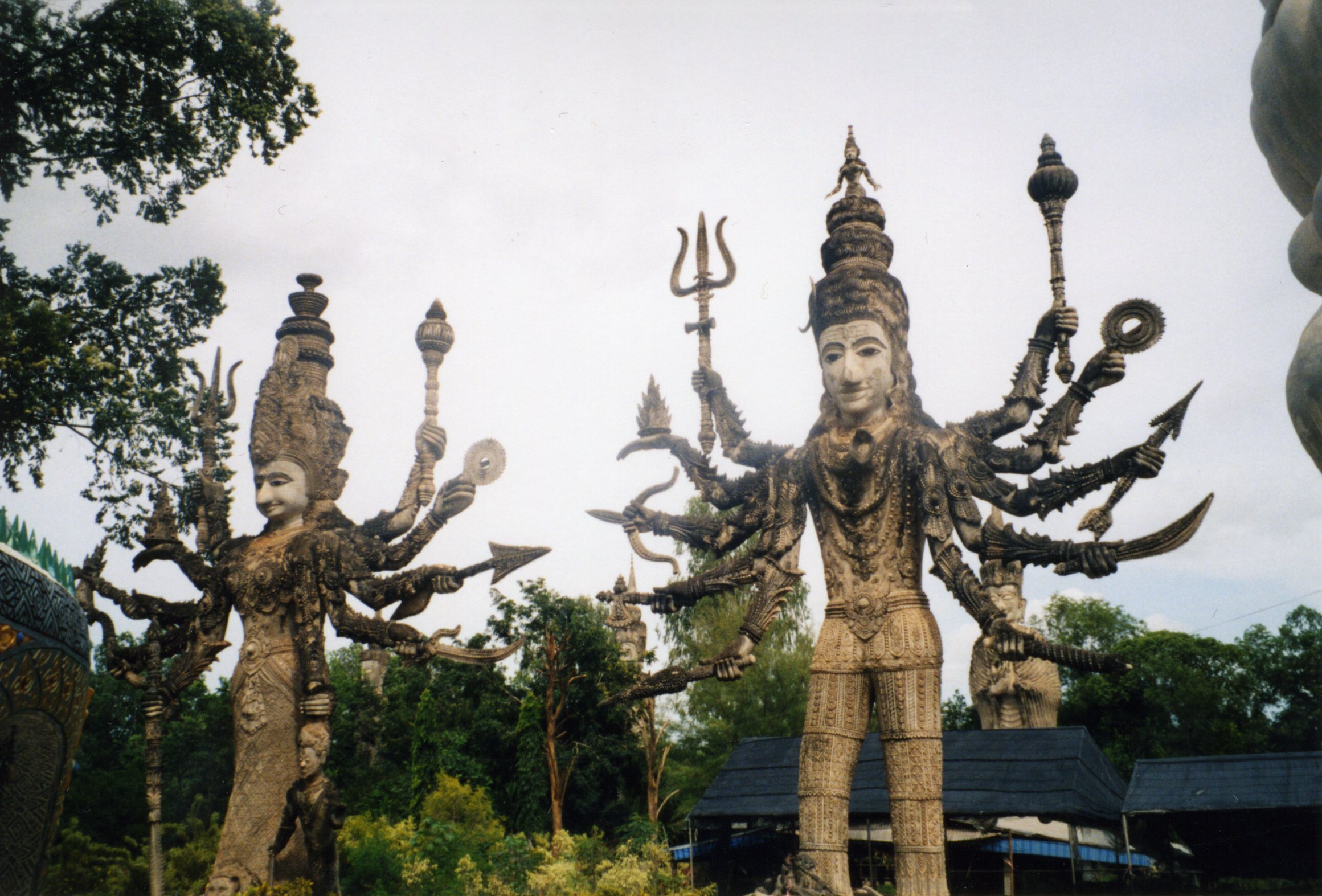
Navegação / Site navigation / Navigatie rond de website
| Sala Kaew Koo é
um parque temático muito original, situado em Nong Khai,
Nordeste da Tailândia. Lá, muitas estátuas gigantescas de
Buda, Shiva e todo o panteon Hindu estão expostas ao ar
livre, representando diferentes cenas entre Homem e Deus.
Este parque foi criado por Luang Puu Bunleua Surirat, um
iogue brama ou 'shaman', com o objetivo de expressar sua
interpretação sincrética das mitologia e filosofia Budista
e Hindu. De acordo com a lenda, ele estava caminhando
pelas montanhas no Vietnam, quando caiu num buraco,
aterrisando diretamente no colo de um 'rishi' (homem
sábio) Hindu, que vivia numa caverna chamada Kaew Koo. Ali
ele permaneceu por vários anos, aprendendo sobre o Budismo
e o Hinduísmo. Por volta de 1958, construiu a "Spirit City" (Xiang Khouan*) no lado laotiano do rio Mekong, a 25km sudoeste de Vientiane. Ali, a principal atração é uma estrutura em forma de abóbora, em que se explora os três planos da existência: inferno, terra e céu. Quando os estalinistas tomaram o poder no Laos, em 1978, Luang Puu fugiu para Nong Khai, onde começou a construir outro parque temático, o Sala Kaew Koo. Presume-se que as estátuas tenham sido esculpidas por artistas amadores, sob sua orientação. O estilo das figuras e incrivelmente uniforme, com rostos que parecem benevolentes máscaras Polinésias. A mais alta de todas, um Buda sentado numa naga enrolada, com várias cabeças, tem 25m. Dentro do parque em Nong Khai existe um local com a coleção de estátuas que descreve "A Roda da Vida". Segundo a filosofia de Luang Puu (avô venerável) "a vida é um tecido composto de influências colocadas nos limites dos horizontes de cada um". Ele tem inúmeros seguidores no Nordeste da Tailândia e no Laos. Acreditava-se que fosse imortal e o guardião da sala de congregação, no parque, garante que apesar de já haverem passado 9 anos desde sua morte, em 1997, seu corpo continua intacto, numa sala no 2o andar. A comunidade faz o que pode pela preservação deste parque, especial e mesmo um tanto exagerado. Existem caixas para coleta de donativos em todos os lugares e sinais de manutenção, substituição de partes danificadas, assim como jardinagem, provam que os seguidores de Luang Puu, após o choque de sua morte inesperada, retomaram as forças outra vez. NavegaçãoNosso website se centraliza no significado deste lugar, seguindo o diagrama acima. Ao olhar a exposição na direção do relógio, é possível fazer-se um tour em volta deste local, mostrando uma foto de cada estátua, com um pequeno comentário sobre o que representa. O diagrama não é a replica exata do que existe na Sala Kaew Koo. Existe uma estátua a mais, após a "partida do Espírito" (á esquerda do 4o Elemento), que nos denominamos "Abandono". Clique nos círculos do diagrama para poder ver as fotos. Cada estátua simboliza um evento, uma influência, um estágio da vida. você pode ir para a estátua seguinte, retornar ao diagrama ou escolher a pagina-índice, para navegar pelo site. Como você pode ver, comparando-se as fotos de 1999 (as duas primeiras e a última da série) com as de 2006, o tempo faz suas marcas no concreto das estátuas. Elas se tornam azul-escuro, devido à umidade que penetra no cimento.Também há uma última foto, tirada do lado de fora (olhando-se em seguida a de Buda – do lado Sudoeste). Sem dúvida alguma, este lugar raro merece ser visitado, por sua originalidade e atmosfera especial. |
Sala Kaew Koo is a
very original "theme park", located in Nong Khai, NE
Thailand. Many enormous statues of Buddha, Shiva and the
entire Hindu pantheon are displayed in a natural
environment, depicting different scenes between man and
god. It was created by Luang Puu Bunleua Surirat, a
brahmanic yogi or shaman, to express his syncretic
interpretation of Buddhist and Hindu mythology and
philosophy. According to the legend, he was walking in the
mountains somewhere in Vietnam, when he fell into a
sinkhole and landed in the lap of a Hindu rishi (wise man)
living in a cave called Kaew Koo. He stayed for many years
learning about Buddhism and Hinduism. Around 1958 he build a "Spirit City" (Xiang Khouan*) on the Lao side of the Mekong River, 25 km SE of Vientiane. The main attraction there is a giant pumpkin structure exploring the three planes of existence: hell, earth and heaven. When the stalinists took over Laos in 1978, he fled to Nong Khai, where he started building another theme park, Sala Kaew Koo. The statues were supposedly cast by unskilled artists under Luang Puu's direction. The style of the figures is remarkebly uniform, with faces that look like benign Polynesian masks. The tallest, a Buddha seated on a coiled naga with a spectacular multiheaded hood, reaches 25m. Inside the park in Nong Khai is an enclosure with a collection of statues that depicts The Wheel of Life. In Luang Puu's (venerable grandfather) philosophy "Life is a pattern of influences ranged around the edge of your horizons". He has a large following in North-Eastern Thailand and Laos. He was supposed to be as good as immortal, and the guardian of the congregation hall insists that even 9 years after his death in 1997, his body remains without decay in a room upstairs. The community is doing what it can to preserve this unique and slightly over the top theme park. Donation boxes are to be found all over the park, and signs of maintenance, replacement of broken pieces and gardening prove that the followers of Luang Puu, after the shock of his unexpected demise, have taken courage again. The numerous speakers all over the park relay a kind of electronic Hindu-funk... in his lifetime, Luang Puu himself was fond of Donna Summer. NavigationOur website focuses on the meaning of the Wheel of Life, following the diagram above. Viewing the exhibition clockwise we offer a tour around this place, showing a picture of each statue with a small comment on its meaning. The diagram isn't really an exact replica of what can be seen at Sala Kaew Koo. There is an extra statue after the Departure of the Spirit (left of the 4th Element), which we call 'Abandonment'. Click on the circles in the diagram to take a look at the photos. Each one is a statue depicting an event, an influence, a stage in life. You can move to the next statue, return to the diagram, or chose the index page to navigate around the site. As you can see by comparing the photos from 1999 (first two and the last of the series) with those of 2006, time takes its toll on the concrete statues. They turn blue-black due to humidity penetrating the cement. Moreover, it was a bright day with hard sunlight in 2006, making it even harder to manage the lighting of the photos.One last shot from outside (looking in next to the Buddha leading man and woman to nirvana - SE side). This unique place is certainly worth a visit because of its originality and particular atmosphere. |
Sala Kaew Koo
is een bijzonder origineel 'themapark' in Nong Khai,
Noordoost Thailand. Talloze enorme standbeelden van
Boeddha, Sjiwa en het complete Hindoe pantheon staan er in
een natuurlijke omgeving en verbeelden verschillende
situaties tussen mensen en goden. Het park werd gecreëerd
door Luang Puu Bunleua Surirat, een brahmaanse yogi of
sjamaan, om zijn eclectische/syncretische interpretatie
van de Boeddhistische en Hindoemythologie en folosofie uit
te drukken. Volgens de legende wandelde hij ergens in
Vietnam door de bergen toen hij in een doline viel en in
de schoot terechtkwam van een Hindoe risji (wijze man) die
in een grot, Kaew Koo, leefde. Bunleua Surirat bleef vele
jaren bij hem om over Boeddhisme en hindoeisme te leren. Rond 1958 bouwde hij een 'Geestenstad' (Xiang Khouan*) aan de Laotiaanse kant van de Mekong rivier, 25 km ten zuidoosten van Vientiane. De voornaamste attractie daar was een reusachtige pompoenstructuur met daarin de drie niveaus van het bestaan: hel, aarde en hemel. Toen de stalinisten aan de macht kwamen in Laos in 1978, vluchtte Luang Puu (eerwaarde grootvader) naar Nong Khai, waar hij een nieuw park begon te bouwen, Sala Kaew Koo. De beelden zijn verondersteld gemaakt te zijn door ongeschoolde kunstenaars onder leiding van Luang Puu. De stijl van de figuren is opmerkelijk gelijklopend, met gezichten die lijken op welwillende Polynesische maskers. Het grootste beeld, een Boeddha op een opgerolde naga met een spectaculaire zevenkoppige kap, is ruim 25 meter hoog. In het park in Nong Khai is een afgebakend geheel dat het Rad van het Leven verbeeldt. In Luang Puu's filosofie is het Leven "een weefsel van invloeden die zich aan de rand van onze horizons voordoen". Luang Puu heeft een grote schare volgelingen in N.O. Thailand en in Laos. Hij werd als haast onsterfelijk beschouwd, en de huisbewaarder van de grote congregatiezaal benadrukt dat zijn lichaam nog steeds geen sporen van verval vertoont in de kamer boven in het gebouw, waar hij al negen jaar, sinds zijn dood in 1997, opgebaard ligt. De gemeenschap doet wat hij kan om dit unieke en lichtelijk gaga park in stand te houden. Bij alle beelden kan je een geldoffer brengen, en tekenen van onderhoud, vervanging van gebroken stukken en tuinonderhoud bewijzen dat de volgelingen, na de shock van zijn onverwacht overlijden, weer moed gevat hebben. Uit de luidsprekers overal in het park klinkt een mengsel van elektronische hindoe-funk... Luang Puu was zelf dol op Donna Summer. NavigatieOnze website focust op de betekenis van het Rad des Levens, op basis van het diagram hierboven. We lopen volgens de wijzers van de klok langs de tentoongestelde beelden, met een kort commentaar bij elke foto. Het diagram is geen exacte weergave van wat er te zien is in het Rad des Levens. Er is een extra beeld tussen het Vertrek van de Geest en het 4e Element. Wij hebben het 'In de steek laten' genoemd. Een klik op de cirkels in het diagram leidt naar een foto van het overeenkomstige beeld. Elke foto toont een beeld dat een gebeurtenis, invloed of stadium in het leven weergeeft. Je kan doorgaan naar het volgende (of vorige) beeld, terugkeren naar het diagram, of naar de indexpagina's gaan om de site te verkennen. Zoals je kan zien door de foto's van 1999 (de eerste twee en de laatste uit de reeks) te vergelijken met die van 2006, eist de tijd zijn tol van de betonnen beelden. Ze slaan blauwzwart uit door het binnendringen van vocht in de cement. Daarbij was het ook een helverlichte dag in 2006, wat het fotograferen niet vergemakkelijkte.Een laatste kijk op de cirkel van buitenuit, rechtsonder (naast de Boeddha die man en vrouw naar nirwana leidt - Zuidoostelijke kant). Deze unieke plaats is zeker een bezoek waard omwille van haar originaliteit en de bijzondere atmosfeer die er heerst. |
